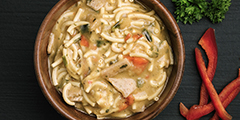Guide: What to eat while hiking?
April 2024 - reading time: 7 minutes
The question of food during outdoor activities, especially hiking, may seem simple for the short term but requires some thought when embarking on several days of self-sufficiency. Several important criteria need to be considered when choosing your food and equipment (especially stoves depending on the type of fuel they use) related to its preparation once on the trails.
|
Contents 2. The advantages of freeze-dried meals |

|
Five essential elements to consider
- Caloric aspect: a day of walking, in all weather conditions, requires a more energetic diet than your usual meals, allowing you to recharge your batteries before hitting the road again, without depleting your reserves and risking exhaustion.
- Weight and size ratio: it's obvious that you need to rationalize these factors, even though, as you hike, you will consume these meals and reduce weight and size.
- Food storage ease: you won't be carrying a fridge on your back, so if you want to bring some fresh food, you'll need to consume it quickly to avoid any intestinal surprises...
- Meals in line with your cooking equipment: if you want to eat hot meals (which I recommend, especially for the long term, as it provides a better energy sensation and immediate comfort in bad weather), choose foods that will be suitable for your cooking equipment, so you don't have to carry extra fuel.
- The pleasure of eating well: choose foods that you enjoy and have flavor! Yes, you can settle for rehydrated couscous with any source of protein, but the idea is to enjoy yourself and not just endure your adventure, and food is a sure way to create good memories. So, try out products, recipes, and consider meals as a source of pleasure rather than just an energy replenishment step.
The advantages of freeze-dried meals:
So, freeze-dried meals meet these criteria, being specialized to facilitate meal consumption for outdoor activities: excellent nutritional values, suitable for sports activities, reduced weight and size, impeccable preservation, easy cooking requiring little water, and balanced menu varieties ensuring satisfaction even for the most skeptical and taking into account the risks of allergies or food intolerances. It's a win-win!
My tips for customizing a freeze-dried meal on the go:
It's possible to enhance these freeze-dried meals by adding fresh products that you'll buy during your stops in villages along your route, or spices, condiments, and spicy oils, for example, easy to include in your meal kit without increasing the weight of your backpack. Personally, I almost always bring either jerky (from dried meat) or pemmican (a mixture of dried meat that I grind in a food processor before mixing, in equal weight with duck fat and a portion of nuts or dried fruits), and thus, I bring an additional dose of protein and fat (not negligible in caloric intake). When I bring rice, I also take Nori sheets (the seaweed used in sushi) that I lightly toast in a pan before rolling them with rice, fish, or cod liver inside.

BEST SELLER
▶▶ Freeze-dried pulled pork ◀◀
A classic outdoor menu mistake to avoid:
❌ There's a food item, often found in hikers' food kits, that I strongly advise against, it's Chinese noodles!❌
Ultimately, low in calories, they're even referred to as empty calories, they're rather indigestible, too salty, and full of saturated fats. If you've come across Ramen Bomb recipes (a mix of ramen with mashed potatoes and all sorts of ingredients), popular among American hikers, forget about them, they're more filling than nutritious.
Snacks (and a homemade recipe!)
Snacks will allow you to easily recharge your batteries while walking. There are plenty of bars available to help maintain your blood sugar levels during exercise, but a mix of dried fruits, nuts, and chocolate pieces, for example, can be interesting to take along. I also like to make my own bars by blending dates, almonds, cashews with a bit of peanut butter and cocoa powder or chocolate squares in a food processor. I then flatten the mixture with a rolling pin before letting it rest in the fridge and cutting it into bars that I wrap in plastic wrap. I won't say more…
To conclude
I can only encourage you to consider your nutrition during hiking (or activities like bike-packing, camping trips, or camping…) in a pleasant and practical way, you'll definitely find something to eat while enjoying your adventure.
SUMMARY: Eating well while hiking, key points to remember
- Pay attention to the energy and nutritional content of your food, which will help you progress and recover well
- Choose rehydratable meals: they are lighter than traditional food and can be stored at room temperature. The kcal /100 g and kcal/ product indicators will help you choose the right food according to the intensity of the effort.
- Eat warm, yes, but with the right equipment and without overloading yourself to avoid adding weight
- Enjoy yourself! Food is a source of comfort. During your hike, recharge your batteries with homemade snacks, energy bars, or mixes of dried fruits.
- Don't forget to hydrate properly!
Yves JEAN, passionate about hiking and bushcraft
🛶 A word about Freeze Dried & Co?
Based in Lorient (Brittany), we are an online shop specialized in outdoor food and equipment. We offer products selected for their quality and designed to accompany outdoor enthusiasts for years.
Our experience allows us to deliver quickly anywhere in Europe. If you have any questions, our experts are available and will be happy to advise you:
☎️ 02 97 87 23 73
📧 team[at]freezedriedandco.com
We also have a store open Monday to Saturday:
📍 6 bis rue du sous-marin Vénus, 56100 Lorient


